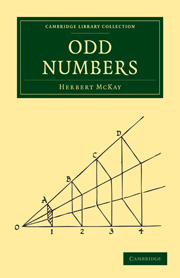Book contents
- Frontmatter
- Contents
- CINDERELLA IN GLASS SLIPPERS
- Millions & Billions & Trillions
- Great Powers & Little Powers
- How we got Logarithms
- Proportion
- Comparisons
- Proportion in Triangles
- Weights & Measures
- The Delusive Average
- Approximations
- Multiplication & Division
- Tables
- Units
- Oddities of Numbers
- The Construction & Solution of Problems
- Scales of Notation
The Construction & Solution of Problems
Published online by Cambridge University Press: 07 September 2010
- Frontmatter
- Contents
- CINDERELLA IN GLASS SLIPPERS
- Millions & Billions & Trillions
- Great Powers & Little Powers
- How we got Logarithms
- Proportion
- Comparisons
- Proportion in Triangles
- Weights & Measures
- The Delusive Average
- Approximations
- Multiplication & Division
- Tables
- Units
- Oddities of Numbers
- The Construction & Solution of Problems
- Scales of Notation
Summary
In his book on Lewis Carroll, Walter de la Mare comments on Lewis Carroll's problems. He quotes a friend as saying: “In some cases the construction of the problem is an almost more remarkable performance than its solution, for the author must have foreseen the details as well as the method of their working, otherwise he would not have been able to arrange his figures so that the answers ‘come out’.”
This statement contains almost every conceivable error that it is possible to make about the construction of problems. In the first place the construction of any ingenious problem is an almost infinitely more remarkable performance than its solution by someone else; solution by the author is part of the process of construction. The author does not usually foresee the details of his problem. In the process of solving it he finds certain awkward points, and he gets over these by introducing suitable numbers. He may find his problem insoluble in its first form and he may have to give further information; one can often detect such added details by the fact that they do not run so smoothly as the rest of the problem. He may find that the problem has two or more answers, and he may add a detail to cut them all out except one. He may disguise some of the information by subtlety of language.
- Type
- Chapter
- Information
- Odd Numbers , pp. 187 - 209Publisher: Cambridge University PressPrint publication year: 2009First published in: 1940

